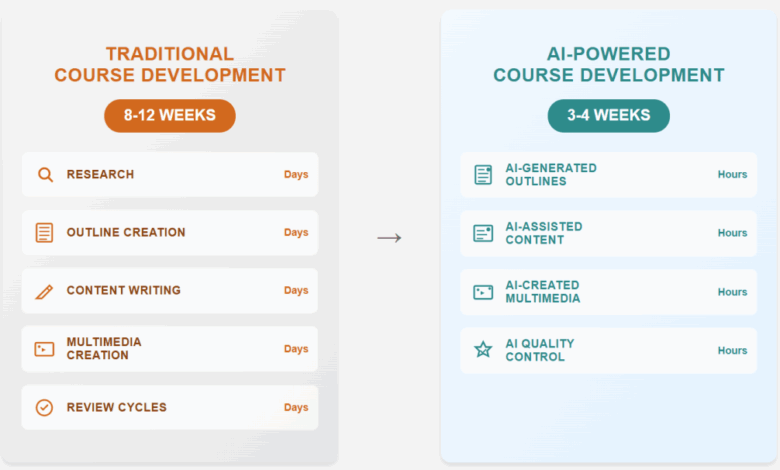Save Time and Boost Productivity: 5 AI Shortcuts for Course Developers

Course development has always been a balancing act. On one hand, you need to create engaging, high-quality educational content that truly serves your learners. On the other hand, you’re racing against time to get courses launched before they become outdated or lose their competitive edge. This tension between quality and speed has kept many instructional designers awake at night, wondering how to do more with less.
The good news? Artificial Intelligence has quietly become the secret weapon that’s helping course developers everywhere break free from this dilemma. But we’re not talking about flashy tech demos or futuristic promises. These are practical, tried-and-tested AI shortcuts that you can start using today to dramatically cut your development time while maintaining the educational impact your learners deserve.
 1. Generate Course Outlines and Scripts in Minutes
1. Generate Course Outlines and Scripts in Minutes
Remember the days when creating a course outline meant hours of brainstorming, research, and restructuring? Those days are behind us. Modern AI can take your basic course idea and transform it into a comprehensive structure faster than you can finish your morning coffee.
Tools like ChatGPT and Claude excel at creating detailed course structures when you provide clear learning objectives and audience details. Coursebox takes this further by specifically designing course outlines with built-in templates for different industries. These platforms can generate module breakdowns, lesson sequences, and even suggest practical exercises that align with your content goals.
Simply provide the AI with your learning objectives, target audience, and desired difficulty level, and watch as it generates detailed module breakdowns, lesson plans, and even suggested activities. The beauty lies in having a solid foundation to build upon rather than starting from a blank page. You can then customize and refine the structure to match your specific needs, saving precious hours that were once spent on initial planning.
2. Automate Content Creation and Adaptation
One of the biggest time drains in course development is adapting existing content for different audiences. Whether you’re converting a technical manual into an interactive module or tailoring a course for various skill levels, AI can handle the heavy lifting.
Jasper AI specializes in rewriting and adapting content for different reading levels and audiences, making complex topics accessible to beginners or adding depth for advanced learners. Copy.ai offers templates specifically designed for educational content transformation, while Writesonic can automatically adjust tone and complexity based on your target demographic.
These tools can automatically summarize lengthy documents, reorganize content flow, and adjust language complexity to match your target audience. This means you can take one piece of source material and quickly create multiple versions for different learner profiles. No more starting from scratch every time you need to adapt content – just smart, efficient reuse with intelligent modifications.
3. Instantly Create Multimedia Resources
Visual and audio elements often become bottlenecks in course development. Finding the right images, recording narrations, or creating custom graphics can consume weeks of your timeline. AI-powered tools are changing this landscape by generating multimedia content on demand.
Midjourney and DALL-E create custom illustrations and graphics that perfectly match your course topics, eliminating the need for expensive stock photos or graphic designers. ElevenLabs produces natural-sounding narrations in multiple languages and voices, allowing you to create professional voice-overs without recording studios. Synthesia goes even further by creating AI-generated video presenters who can deliver your content in various languages and styles.
These tools produce coherent, professional-quality multimedia resources that align with your content, eliminating one of the slowest stages of instructional design. You can generate custom visuals, professional narrations, and even interactive video content in minutes rather than weeks.
4. Get Smart Activity and Assessment Suggestions
Creating engaging exercises and meaningful assessments requires creativity and deep understanding of learning principles. Sometimes, even experienced designers hit creative blocks when trying to develop activities that truly reinforce learning objectives.
Quillionz analyzes your course content and automatically generates various types of questions including multiple choice, true/false, and short answer questions that test different cognitive levels. Kahoot uses AI to suggest interactive quiz formats and gamification elements that boost engagement. H5P offers AI-powered recommendations for interactive content types that work best with your specific learning objectives, from drag-and-drop activities to scenario-based simulations.
These systems analyze your course content and learning goals to suggest specific activities that promote engagement and knowledge retention. From interactive scenarios to assessment questions, these tools provide fresh ideas that you might not have considered, ensuring variety in your course design while saving you from creative fatigue.
5. Streamline Review and Quality Control
The review process can be a time-consuming cycle of edits and revisions. AI-powered editing tools can analyze your course materials for errors, clarity issues, and style inconsistencies before human eyes ever see them. This means you can deliver higher-quality courses with fewer revision cycles.
Grammarly goes beyond basic spell-check to analyze tone, clarity, and engagement levels in your educational content, ensuring your writing connects with learners. Hemingway Editor helps simplify complex sentences and identifies areas where your content might be too difficult for your target audience. ProWritingAid provides detailed reports on readability, sentence structure, and even suggests improvements for better learning comprehension.
These tools don’t just catch typos – they can suggest improvements to sentence structure, identify unclear explanations, and even flag potential accessibility issues. By handling the initial quality control, AI frees you to focus on the bigger picture aspects of your course design.

The Real Impact
Using these AI shortcuts isn’t just about working faster – it’s about working smarter. When you eliminate repetitive tasks and streamline routine processes, you create space for the work that truly matters: crafting meaningful learning experiences that connect with your audience.
The key is understanding that AI doesn’t replace human creativity and expertise. Instead, it handles the foundational work so you can focus on the strategic decisions that make courses truly exceptional. You still bring the vision, the pedagogical knowledge, and the understanding of your learners’ needs. AI simply removes the barriers that have traditionally slowed you down.
The future of course development is already here, and it’s more efficient than ever. By embracing these AI shortcuts, you’re not just keeping up with the times – you’re positioning yourself to create better courses faster, giving your learners the timely, relevant education they need while maintaining the quality standards they deserve.




